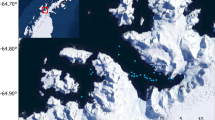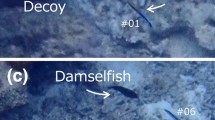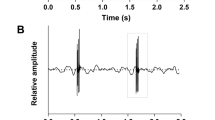Abstract
Group fission and fusion processes are driven by state dependence, risk and the availability of information from others. Yet the availability of information changes under different environmental conditions, thus aiding or inhibiting group formation and maintenance. Chemical cues provide information on the location of individuals and can act as a mechanism for individuals to group together, although they can be greatly affected by environmental conditions. Using a flow channel, we studied how one shoaling fish species, the Pacific blue-eye (Pseudomugil signifer), responds to conspecific chemical cues (CCCs) in different environmental conditions (salinities). This species lives in estuarine environments, ranging in salinity from fresh to fully marine. P. signifer responded to CCCs in freshwater but not in saltwater. Furthermore, P. signifer did not respond to saltwater with CCCs added from freshwater. It took significantly longer for fish in saltwater, than in freshwater, to locate and join a shoal when only CCCs from the shoal were present. Finally, fish formed more cohesive shoals in freshwater than in brackish or saltwater. These results suggest that these fish do not rely on chemical cues in saltwater to locate conspecific shoals. Furthermore, the reduced amounts of these cues in saltwater may inhibit the maintenance of tight shoal structures. We suggest that fish utilise different sensory modalities in fresh or saltwater in order to locate one another, or the social structure of these groups is fundamentally different between these two water types. The importance of this study in relation to understanding how animals utilise and change different sensory modalities in varying environmental conditions is discussed.






Similar content being viewed by others
References
Allison JD, Carde RT (2008) Male pheromone blend preference function measured in choice and no-choice wind tunnel trials with almond moths, Cadra cautella. Anim Behav 75:259–266
Almeida OG, Miranda A, Frade P, Hubbard PC, Barata EN, Canario AVM (2005) Urine as a social signal in the Mozambique tilapia (Oreochromis mossambicus). Chem Sens 30:309–310
Breder CM (1959) Studies on social groupings in fishes. Bull Amer Mus Nat Hist 117:393–481
Brown GE, Godin JGJ (1997) Anti-predator responses to conspecific and heterospecific skin extracts by threespine sticklebacks: alarm pheromones revisited. Behav 134:1123–1134
Brumm H (2006) Signalling through acoustic windows: nightingales avoid interspecific competition by short-term adjustment of song timing. J Comp Phys A Neuroethol Sens Neural Behav Phys 192:1279–1285
Byrne PG, Keogh JS (2007) Terrestrial toadlets use chemosignals to recognize conspecifics, locate mates and strategically adjust calling behaviour. Anim Behav 74:1155–1162
Ey E, Rahn C, Hammerschmidt K, Fischer J (2009) Wild female olive baboons adapt their grunt vocalizations to environmental conditions. Ethol 115:493–503
Fisher HS, Rosenthal GG (2006) Female swordtail fish use chemical cues to select well-fed mates. Anim Behav 72:721–725
Fornasiero S, Bresciani E, Dendi F, Zuffi MAL (2007) Pheromone trailing in male European whip snake, Hierophis viridiflavus. Amphib Reptil 28:555–559
Gauthier S, Rose GA (2002) Acoustic observation of diel vertical migration and shoaling behaviour in Atlantic redfishes. J Fish Biol 61:1135–1153
Gherardi F, Tricarico E, Atema J (2005) Unraveling the nature of individual recognition by odor in hermit crabs. J Chem Ecol 31:2877–2896
Hamilton WD (1971) Geometry for the selfish herd. J Theo Biol 31:295–311
Hemmings CC (1966) Olfaction and vision in fish schooling. J Exp Biol 45:449–464
Heuschele J, Candolin U (2007) An increase in pH boosts olfactory communication in sticklebacks. Biol Lett 3:411–413
Heuschele J, Mannerla M, Gienapp P, Candolin U (2009) Environment-dependent use of mate choice cues in sticklebacks. Behav Ecol 20:1223–1227
Hubbard PC, Barata EN, Canario AVM (2003) Olfactory sensitivity of the gilthead seabream (Sparus auratus) to conspecific body fluids. J Chem Ecol 29:2481–2498
Jones FRH (1956) The behaviour of minnows in relation to light intensity. J Exp Biol 33:271–281
Krause J, Ruxton GD (2002) Living in groups. Oxford University Press, Oxford
Lautala T, Hirvonen H (2008) Antipredator behaviour of naive Arctic charr young in the presence of predator odours and conspecific alarm cues. Ecol Freshw Fish 17:78–85
Lihoreau M, Zimmer C, Rivault C (2007) Kin recognition and incest avoidance in a group-living insect. Behav Ecol 18:880–887
McCormick SD (2001) Endocrine control of osmoregulation in teleost fish. Amer Zoo 41:781–794
Moore A, Ives MJ, Kell LT (1994) The role of urine in sibling recognition in Atlantic salmon Salmo salar parr. Proc R Soc Lon Ser B-Bio Sci 255:173–180
Nava SS, Conway MA, Martins EP (2009) Divergence of visual motion detection in diurnal geckos that inhabit bright and dark habitats. Funct Ecol 23:794–799
Obrist MK (1995) Flexible bat echolocation—the influence of individual, habitat and conspecifics on sonar signal design. Behav Ecol Sociobiol 36:207–219
Olsen KH, Grahn M, Lohm J, Langefors A (1998) MHC and kin discrimination in juvenile Arctic charr, Salvelinus alpinus. Anim Behav 56:319–327
Pusey B, Kennard M, Arthington A (2004) Freshwater fishes of Northeastern Australia. CSIRO Publishing, Sydney
Secondi J, Haerty W, Lode T (2005) Female attraction to conspecific chemical cues in the palmate newt Triturus helveticus. Ethol 111:726–735
Sorensen PW, Stacey NE (1999) Evolution and specialization of fish hormonal pheromones. In: Johnston et al (eds) Advances in chemical signals in vertebrates. Kluwer Academic, New York, pp 15–47
Sorensen PW, Christensen TA, Stacey NE (1998) Discrimination of pheromonal cues in fish: emerging parallels with insects. Cur Opin Neurobiol 8:458–467
Spooner GM (1931) Some observations on schooling in fish. J Mar Biol Assoc UK 17:421–448
Stacey NE, Sorensen PW, Vanderkraak GJ, Dulka JG (1989) Direct evidence that 17-alpha, 20-beta-dihydroxy-4-pregnen-3-one functions as a goldfish primer pheromone - Preovulatory release is closely associated with male endocrine responses. Gen Compar Endocrin 75:62–70
Taga ME, Bassler BL (2003) Chemical communication among bacteria. Proc Nat Acad Sci USA 100:14549–14554
Todd JH, Atema J, Bardach JE (1967) Chemical communication in social behaviour of a fish—yellow bullhead (Ictalurus natalis). Sci 158:672–673
Torisawa S, Takagi T, Fukuda H, Ishibashi Y, Sawada Y, Okada T, Miyashit S, Suzuki K, Yamane T (2007) Schooling behaviour and retinomotor response of juvenile Pacific bluefin tuna Thunnus otientalis under different light intensities. J Fish Biol 71:411–420
Ward AJW, Axford S, Krause J (2002) Mixed-species shoaling in fish: the sensory mechanisms and costs of shoal choice. Behav Ecol Sociobiol 52:182–187
Ward AJW, Duff AJ, Horsfall JS, Currie S (2008) Scents and scents-ability: pollution disrupts chemical social recognition and shoaling in fish. Proc R Soc B-Biol Sci 275:101–105
Webster MM, Adams EL, Laland KN (2008) Diet-specific chemical cues influence association preferences and prey patch use in a shoaling fish. Anim Behav 76:17–23
Webster MM, Goldsmith J, Ward AJW, Hart PJB (2007) Habitat-specific chemical cues influence association preferences and shoal cohesion in fish. Behav Ecol Sociobiol 62:273–280
Wyatt TD (2003) Pheromones and animal behaviour—communication by smell and taste. Cambridge University Press, Cambridge
Acknowledgements
We would like to thank Mike Webster, Angus Jackson, Tony Underwood and two anonymous referees for stimulating discussion and comments on previous versions of this manuscript.
Author information
Authors and Affiliations
Corresponding author
Additional information
Communicated by J. Krause
Ethical note
The approval number for this study was: L04/3-2008/1/4766, granted by the University of Sydney’s Animal Ethics Committee. After the experiment was completed, fishes were returned to where they were caught. Fishes were kept in captivity for a maximum of 6 months.
Rights and permissions
About this article
Cite this article
Herbert-Read, J.E., Logendran, D. & Ward, A.J.W. Sensory ecology in a changing world: salinity alters conspecific recognition in an amphidromous fish, Pseudomugil signifer . Behav Ecol Sociobiol 64, 1107–1115 (2010). https://doi.org/10.1007/s00265-010-0925-0
Received:
Revised:
Accepted:
Published:
Issue Date:
DOI: https://doi.org/10.1007/s00265-010-0925-0




